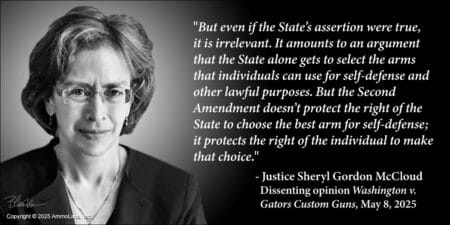
Today, the Supreme Court of The United States heard oral arguments in Garland v. Cargill, which will determine the legality of bump stocks across the country.
Michael Cargill, a Texas resident, sued the federal government over the Bureau of Alcohol, Tobacco, Firearms and Explosives (ATF) rule banning bump stocks and declaring them to be machine guns. The rule was created at the urging of then-President Donald Trump after a Las Vegas shooting in which the shooter allegedly used an AR-15 equipped with a bump stock to kill 50 people in 2017.
Instead of Congress passing a new law, the ATF created a new administrative rule changing its long-standing opinion that bump stocks are not machine guns. This new rule had the force of law. Congress was unwilling to enact a law banning the device. Many in the gun community took issue with the Bureau’s action and claimed that they overstepped their power and made a de facto law.
Mr. Cargill lost in a Texas Federal District Court and appealed the court’s decision to the Fifth Circuit Court of Appeals. The en banc of the Fifth Circuit sided with Cargill by a 13 to 3 margin, citing that the ATF violated the Administrative Procedures Act (APA). Although that was key in the Fifth Circuit case, that issue did not arise in the oral arguments before SCOTUS.
The argument before the Supreme Court centers around what a “single function of the trigger” is. The government insists that a single function of the trigger is the original pull and any action after the pull of the trigger. The government lawyer also argued that the forestock is part of a trigger.
The plaintiffs claim that the function of the trigger is limited to the mechanical action of the trigger itself. The lawyers for Mr. Cargill stated that since the user must manually push forward on the forestock, shooting multiple rounds using a bump stock is not automatic and does not convert the firearm into a machine gun.
Justice Samuel Alito seemed to agree with the plaintiffs and asked why the releasing of the hammer by the sear was not considered the function of the trigger. Judge Clarence Thomas also seemed hostile towards the government’s decision to reclassify bump stocks as machine guns. The other conservative justices didn’t seem to be in the same camp.
Justice Ketanji Brown Jackson was openly hostile towards the plaintiff’s stance. She tried to state that if something makes a gunfire rapidly, it should be a machine gun. She seemed unfamiliar with firearm operation and firearm technology.
Justice Sonia Sotomayor tried to argue that it isn’t about the function of the trigger but is about the function of the shooter. Justice Sotomayor seemed to be arguing that bump stocks violate the spirit of the law rather than the actual text of the National Firearms Act (NFA).
Justice Elena Kagan, through multiple hypothetical arguments, tried to imply that the bump stock is a device designed to circumvent the law regulating machine guns. Justice Kagan even asked about a voice-activated trigger, which doesn’t exist. She seemed to be taking the stance of Justice Sotomayor.
The plaintiff’s lawyer spent most of the time being grilled by the justices over the arguments. It is hard to determine what the conservative justices will do in the case, but there is no doubt what the liberal justices will do.
About John Crump
John is a NRA instructor and a constitutional activist. John has written about firearms, interviewed people of all walks of life, and on the Constitution. John lives in Northern Virginia with his wife and sons and can be followed on Twitter at @crumpyss, or at www.crumpy.com.







The justices who do not rule according to the letter of the law and the Constitution must be removed. Rate of fire or intention have zero to do with the definition of a machine gun. Only Congress can write criminal law, not agencies nor courts, and not even Congress has the Constitutional authority to infringe on the right to keep and bear arms, so every damn one of the 23,000+ gun laws are moot.
“It is hard to determine what the conservative justices will do in the case, but there is no doubt what the liberal justices will do.”
Well doesn’t that just sum up the fundamental problem of the age these days!!
That should be the opening line of the article!
If the court wrongly decides BATFE can alter laws and change definitions set by Congressional statute, the court is irrelevant to citizens… and all our rights exist only when we forcibly defend and exercise them, because government agencies will reimagine and reinterpret all of them in authoritarian fashion. BATFE will claim rate of fire makes a machine gun, as well as the ability to alter a weapon to increase its rate of fire, and thus ban binary triggers, AR’s and all other semiautos. They’re already trying to set up a ban on AR’s by redefining “readily” to mean a full… Read more »
on a full automatic, if you hold the trigger back by a wire twist or zip tie, it fires until out of ammo even if you put it down. if a bump stock doesn’t do this, it isn’t a ‘machine gun’.
<mic drop>
It will also be very interesting how this decision either compliments or contradicts the Chevron case.
If we “win” both, it’ll be a very good thing. If we “lose” both, well, that’s pretty much the end of the Constitution as it was intended.
BAN token hires.
ALL Cargills not well prepared attorney needed to do was show an animation of how the trigger functions (the fire control group) in both semi and full auto, and the difference. His argument would have been simplified……
I will actually be shocked if the court jesters don’t decide with the ATF. We all know what time it is, but are afraid to actually say it.
Cargill’s lawyer lost the case for U.S. his inability to articulate the key points was a disaster. Clearly not a gun guy.
Early in the history of our Republic and prior to that in England and elsewhere if you wanted to become a lawyer you did not go to law school. You found an established lawyer and became an apprentice. Under that lawyer’s supervision and tutelage you ‘read the laws.’ If folks asked you what you were doing with your time you responded by stating ‘I am reading the laws.’ It seems we have three member of the Supreme Court and many on the federal bench who would benefit from such an apprenticeship program. Maybe under close. supervision they too could ‘read… Read more »